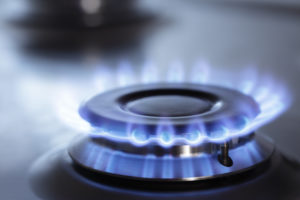 Natural gas rose on Wednesday after falling the most in six months ahead of what could be one of the lowest inventory builds during the replenishment season and as short-term weather forecasts called for a brief surge in temperatures over the Midwest and Eastern US. However, expectations for comfortable readings during most of September with the return of stockpile gains almost doubling the five-year average kept gains limited.
Natural gas rose on Wednesday after falling the most in six months ahead of what could be one of the lowest inventory builds during the replenishment season and as short-term weather forecasts called for a brief surge in temperatures over the Midwest and Eastern US. However, expectations for comfortable readings during most of September with the return of stockpile gains almost doubling the five-year average kept gains limited.
On the New York Mercantile Exchange, natural gas futures for settlement in October rose by 0.28% to $3.901 per million British thermal units by 09:44 GMT. Prices ranged between days high and low of $3.914 and $3.891 per mBtu. The energy source lost 4.3% on Tuesday, the biggest drop in six months, to settle at $3.890.
The power-plant fuel gained some ground on Wednesday after Tuesdays steep drop and as short-term weather forecasts pointed to a brief rise in temperatures across the Midwest and eastern parts of the US.
Moreover, last weeks overall warm weather will be the reason for what will probably be one of the lowest inventory builds which is due to be reported tomorrow. According to Tim Evans, an energy analyst at Citi Futures in New York, US gas inventories probably rose by 70 billion cubic feet (bcf) in the week ended August 29th. NatGasWeather.com analysts expect a gain in the range of 73 and 76 bcf.
According to NatGasWeather.com, cooling demand within the September 3rd – 9th time span is expected to be moderate compared to normal as temperatures across the Midwest and eastern US will briefly rise into the 80s. The southern US will also see a few degrees of warming, with highs reaching into the mid and upper 90s.
However, a following cooler Canadian weather system will sweep across the central and eastern US by the weekend, carrying showers, thunderstorms and slightly cooler-than-seasonal temperatures. This will bring cooling demand across most of the US to moderate-to-low.
Between September 10th and 16th, cooler weather systems tracking across the northern US will bring comfortable temperatures in the region, reflecting a neutral to slightly-cooler trend. The Canadian weather systems will also push fairly deep into Texas and the Southern Plains, lowering highs to the upper 80s and lower 90s compared to the recent upper 90s and lower 100s. As a result, national cooling demand is expected to noticeably decrease, paving the way for the return of 85+ bcf inventory builds.
“We continue to believe there will be more downside pressure on prices over the next month or so,” NatGasWeather.com analysts said in a note to clients. “However, the next few days could give back a bit of Tuesday’s losses as warmer temperatures briefly return to the Midwest and East Coast and combine with one of the lowest builds of the year when released Thursday by the EIA. After the weekly report is behind us, weather patterns should provide nothing but much larger builds to come with deficits continuing to make up ground in steady chunks for many weeks to come.”
According to AccuWeather.com, the high in New York on September 6th will be 90 degrees Fahrenheit, 11 above usual, before sliding back to as much as 74 degrees four days later. Chicago will reach 86 degrees on September 4th, 7 above the average, followed by a drop to 73-76 degrees through September 11th and a further slide to 60-64 degrees between September 12th and September 16th.
To the South, Texas City will see readings peak at 90 degrees on September 5th and 6th, 1 above usual, before easing to as much as 82 degrees on September 14th. On the West Coast, the high in Los Angeles on September 6th will be 88 degrees, 4 above usual, but readings will ease to seasonal levels through September 13th.
Technical support and resistance
According to Binary Tribune’s daily analysis, October natural gas futures’ central pivot point stands at $3.951. In case the contract penetrates the first resistance level at $4.017 per million British thermal units, it will encounter next resistance at $4.144. If breached, upside movement will probably attempt to advance to $4.210 per mBtu.
If the energy source drops below its first support level at $3.824 per mBtu, it will next see support at $3.758. If the second key support zone is breached, the power-station fuel’s downward movement may extend to $3.631 per mBtu.





